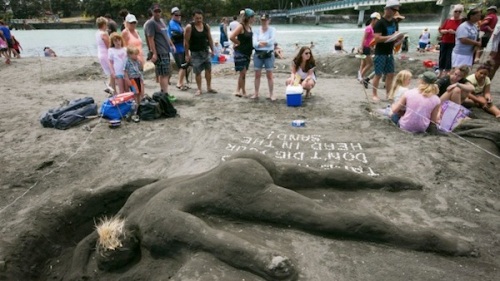Lihir Mine Continues to be a Headache
Rhiannon Hoyle | The Wall Street Journal
Few companies have experienced the ups and downs of the commodities cycle like Newcrest Mining Ltd., Australia’s biggest gold producer, whose shares have soared as high as 36 Australian dollars (US$28) and crashed to as low as A$7 over the past three years.
One of the worst periods was 2013, when Australia’s securities watchdog began investigating the company’s disclosure practices; its chairman and chief executive both said they were quitting; and it was forced into a humiliating US$6 billion write-down of assets it purchased during gold’s decadelong bull run.
More recently, Newcrest has begun to recover some of its shine. Its shares are trading at an 18-month high, buoyed by the weekslong run-up in gold prices amid concern over the health of the global economy. And on Friday, Newcrest surprised investors by setting a higher annual production target.
The company said it expected to produce between 2.3 million and 2.5 million troy ounces of gold in the year through June, compared with an earlier 2.2 million-2.4 million forecast. Management also reported a 2.7% increase in gold output in the final three months of last year, and lifted its estimate for copper output in the current fiscal year by up to 20%.
The brighter news, announced in a second-quarter update, follows a spate of production downgrades in recent years, and routine disappointment for shareholders when hoped-for guidance upgrades failed to materialize.
A one-time darling of Australia’s share market, Newcrest has faced setbacks of almost every sort: from engineering faults at its mines and rain disrupting operations to unexpected tax bills. The producer, which was forced into write-downs as recently as August, has been working hard to rebuild its image by focusing on improving the reliability of its global operations.
Still, Friday’s upgrades failed to put much of a spark under Newcrest’s stock, which has already risen by more than 25% this year. Investors remain concerned, mainly, about the outlook for its Lihir mine in Papua New Guinea, which Newcrest acquired as part of its A$9.5 billion takeover of Australian-listed rival Lihir Gold Ltd. back in 2010.
The mine, which Newcrest had high hopes for, has faced repeated setbacks, including several unplanned disruptions caused by problems with processing machinery and conveyor belts at its facilities.
“Lihir continues to underperform against its potential,” Newcrest’s chief executive, Sandeep Biswas, said on Friday, but added that he was confident the right strategy and people were now in place to boost production at the operation. Gold output at the facility was below the company’s expectations and costs rose, the company said in the quarterly update.
The performance of Newcrest’s other operations was patchy. It recorded strong second-quarter output at its Cadia and Telfer mines in Australia, but weaker-than-anticipated production at its Gosowong mine in Indonesia and Hidden Valley operation in Papua New Guinea.
A pullback in the gold price in recent days is also causing investors to tread carefully, according to local fund managers. Gold futures posted their sharpest decline—2.4%–in more than a year on Thursday as a more-hawkish Federal Reserve signaled the U.S. economy was strengthening, dampening demand for bullion which is often treated as a haven in turbulent times.
“Even if management resolve the issues at Lihir, it’s certainly going to be a difficult proposition to show increasing profits when gold faces such a big macro headwind,” said Angus Gluskie, managing director of White Funds Management in Sydney, pointing to the scope for the greenback to strengthen when U.S. interest rates eventually climb, reducing the allure of gold to investors.
_ _ _ _ _
Newcrest lifts gold production target
AUSTRALIA’S biggest gold miner Newcrest has lifted its full year production target while lowering its costs.
CHIEF executive Sandeep Biswas said he was happy with Newcrest’s Australian mines, but disappointed with the performance of its major Lihir operations in Papua New Guinea, which achieved a lower than expected production increase.
Milling operations at another PNG mine were also stopped for 17 days following the death of a worker in early December.
Stronger than expected overall production in the three months to December was achieved as capacity upgrades at Newcrest’s largest Australian operation, in NSW’s central west, progressed ahead of schedule.
Newcrest now expects to produce between 2.3 million and 2.5 million ounces of gold in the 2014/15 year, up 100,000 ounces on its previous guidance.
Copper production guidance has also been lifted to a range of 90,000 to 100,000 tonnes, up from the previous guidance of 75,000 to 85,000 tonnes.
Newcrest also lowered its full year all-in sustaining cost guidance, to a range of $2.3 billion and $2.5 billion, due to stronger copper production and improved efficiencies.
But the company’s shares have fallen, as the gold price endured its sharpest drop in more than a year.
The price fell due to a stronger US dollar, and a move by traders into other investments in anticipation of an interest rate rise in the US.
Newcrest shares dropped 14 cents to $13.56.









